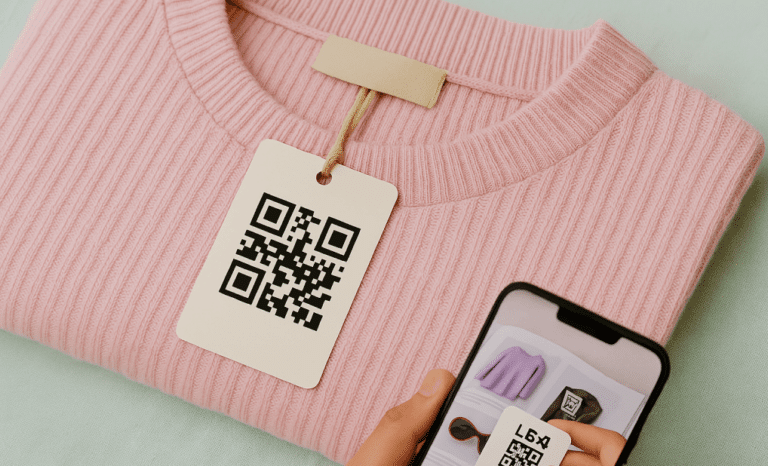What are QR codes in the fashion industry?
In fashion, details matter—and that includes the small, square ones. QR codes in fashion industry might look simple, but in the fashion industry, they’re quietly transforming how brands talk to their customers.
You’ll find them everywhere: on clothing tags, care labels, hang tags, or printed right onto sleek product packaging. And with just a quick scan—on the go or in the fitting room—shoppers get more than just info. They get styling tips, loyalty perks, size guides, even access to exclusive discounts.
But QR codes aren’t just about convenience. Fashion brands are using them to pull back the curtain—sharing behind-the-scenes content, promoting sustainable fashion choices, or creating AR experiences that let customers try before they buy (virtually, anyway).
In short? These little codes aren’t background tech. They’re front-row players in fashion marketing—connecting physical items to digital worlds, building brand recognition, and making every customer interaction feel more personal, more useful, and way more engaging.
How are fashion brands using QR codes today?
These days, QR codes are doing a lot more than just sitting quietly on product tags—they’re becoming part of the shopping experience itself. Fashion brands are using them as digital bridges, turning everyday moments into interactive touchpoints.
Scan a code on a clothing label or shelf display, and instead of guessing, you’re watching a product video, checking stock in your size, or getting a quick styling tip—right then and there.
Online, those same QR codes take you straight to a brand’s social media page, a review platform, or a curated landing page. No searching, no scrolling—just tap and go.
They’re also front and center in fashion marketing campaigns. Branded QR codes unlock limited-time discounts, tease upcoming collections, or trigger immersive augmented reality experiences. It’s all part of a bigger shift: creating a seamless, digital-first customer journey that feels personal, dynamic, and a little more exciting with every scan.
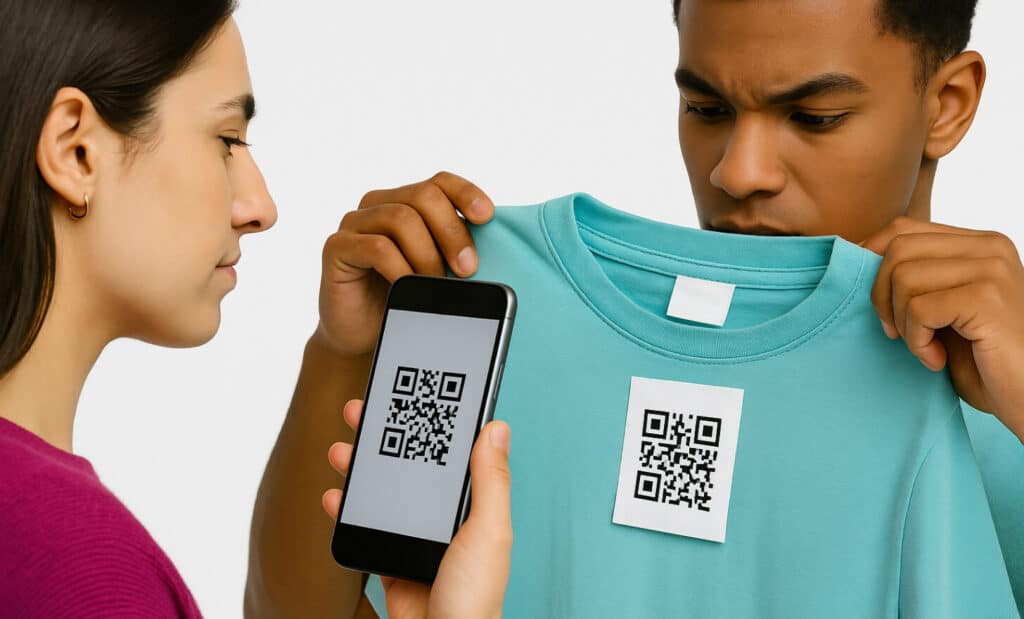
Why are dynamic QR codes a powerful tool for fashion?
In fashion, things move fast—collections drop, trends shift, and marketing pivots happen overnight. That’s exactly why dynamic QR codes are such a valuable tool for fashion brands.
Unlike static codes, which are locked in once printed, dynamic QR codes let you switch up the destination link anytime. No need to reprint hang tags or relabel packaging. One week the code links to care instructions, the next it leads to a loyalty reward or an early look at the next collection.
Even better? Brands can tailor the experience based on location, language, or stock availability—making each scan feel smarter and more relevant.
It’s quick, flexible, and sustainable. And in an industry that thrives on creativity and timing, dynamic QR codes help brands stay agile, connected, and ahead of the curve.
What benefits do QR codes offer to fashion marketers?
For fashion marketers, QR codes are like digital Swiss Army knives. They turn everyday brand assets—like clothing tags, product packaging, or even a store window—into clickable entry points for deeper engagement.
With one simple scan, customers land on styling guides, online stores, or curated social media content. That quick jump from physical to digital helps boost both engagement and conversions without adding friction.
They’re also a win for sustainable fashion. By replacing printed brochures or care manuals with digital content, brands reduce waste and stay aligned with eco-conscious values.
And with dynamic QR codes, marketers can update content in real time, collect first-party data through opt-ins or surveys, and fine-tune campaigns on the go. It’s not just efficient—it’s the kind of responsive, insight-driven approach modern fashion marketing demands.
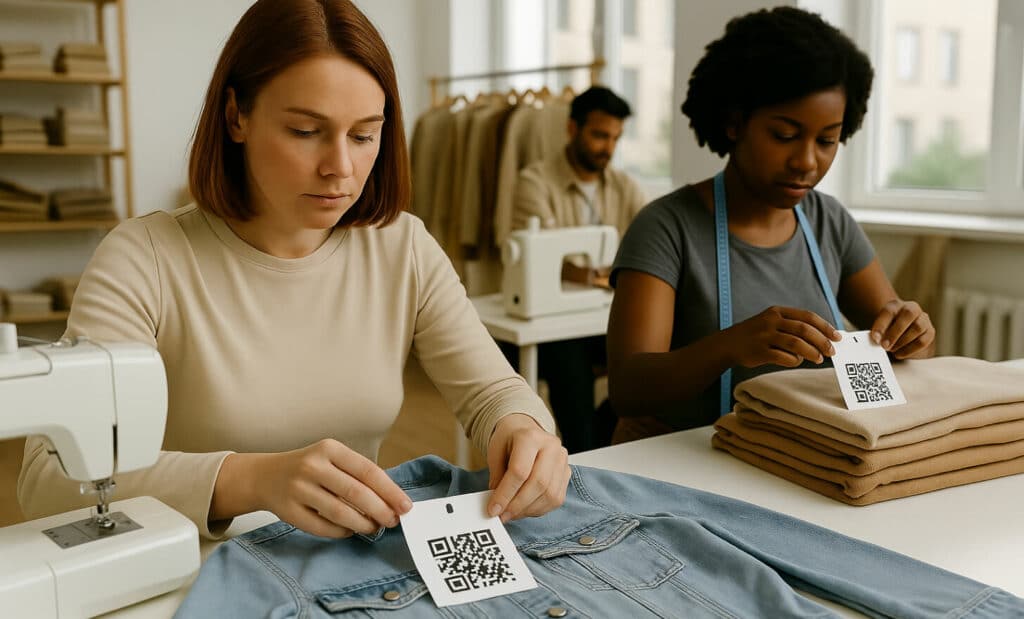
Can QR codes improve customer engagement in fashion?
Absolutely. In an industry built on connection, QR codes give fashion brands a simple way to spark deeper, more meaningful interactions. One quick scan on a tag or display, and shoppers get instant access to styling tips, size guides, product videos, or exclusive discounts.
But the engagement doesn’t stop at the store exit. QR codes can link to online store pages, social media platforms, or even review pages—extending the brand experience well beyond the physical space. Some unlock behind-the-scenes content. Others launch virtual try-ons.
The result? A more interactive, personalized journey that builds trust, strengthens brand recognition, and keeps your fashion brand top of mind—long after the first scan.
How do QR codes enhance product packaging and hang tags?
Think of QR codes as hidden doors on your packaging and hang tags—ready to open with just a scan. They instantly give customers access to care instructions, styling ideas, stock availability, or even behind-the-scenes content—all without needing to hunt for it.
Instead of stuffing in printed inserts or extra materials, brands can offer cleaner, more sustainable packaging that connects to rich digital resources. A simple hang tag might lead to a video showing how to style the item three different ways—or link to a digital care label that lives online.
It’s a clever way to deliver value, reduce waste, and turn everyday product labels into powerful touchpoints that boost customer engagement and promote sustainable fashion.
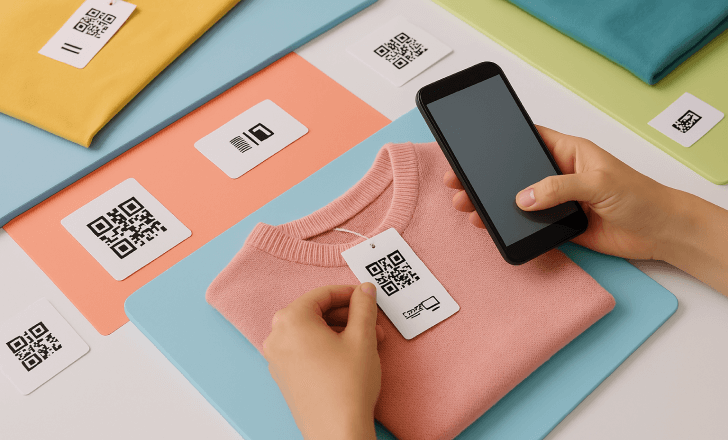
Are QR codes helping promote sustainable fashion?
No question about it. QR codes are becoming quiet heroes in the push for sustainable fashion. Instead of relying on printed booklets or extra packaging, fashion brands are using them to share digital content—instantly and waste-free.
Scan a care label or product tag, and you’ll find details about materials, ethical sourcing, or carbon footprint. Some even break down the environmental impact of that specific item.
It’s a simple shift with big impact: less paper, more transparency, and better-informed shoppers who care about where and how their clothing is made. In a world leaning toward ethical practices, QR codes help brands walk the talk.
What role do QR codes play in personalized shopping?
QR codes are turning one-size-fits-all retail into something a lot more tailored. Scan a clothing tag, and instead of static info, you might get styling suggestions, color or size availability, or a lookbook curated to your tastes.
Some fashion brands go even deeper—linking integrated QR codes to CRM systems to trigger personalized rewards, loyalty perks, or even recommendations based on previous behavior.
It’s not just smart marketing. It’s a way to make every shopper feel seen, understood, and catered to—whether they’re browsing in-store or online.
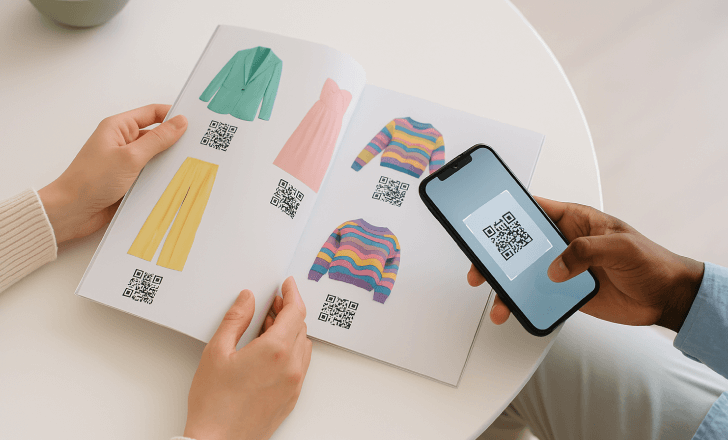
How are QR codes used on clothing labels and care tags?
QR codes on clothing labels and care tags are no longer just nice-to-have—they’re becoming standard across the fashion industry. With a quick scan, customers can access washing instructions, fabric details, product origin, or even the environmental impact of the item they’re holding in their hands.
In sustainable fashion and premium collections, these quick response codes often double as digital product passports. They verify authenticity, explain ethical practices, or link to care videos and certifications that help build trust.
For technical or high-end clothing, integrated QR codes can also include a breakdown of materials, color scheme options, or tips on how to extend the life of the garment.
By replacing printed inserts with digital content, brands reduce waste and create a smarter, more transparent shopping experience. Whether in a physical store or browsing online, QR codes on clothing tags give customers the tools to make better decisions—while reinforcing brand recognition and promoting sustainability in a very real, practical way.
What’s the impact of QR codes on fashion shows and events?
Fashion shows and events have always been about the wow factor—but now, QR codes are adding a whole new layer of interaction. You’ll see them on digital screens, printed invites, or even stitched into what the models are wearing. And with one quick scan, guests can shop the look, access exclusive backstage content, or unlock an augmented reality experience right from their seats.
At brand activations, pop-ups, and exhibitions, QR codes are everywhere—connecting visitors to online stores, social media pages, or limited-edition drops before the moment slips away. Some offer styling tips or VIP signups; others drive traffic to influencer-led campaigns that keep the buzz going long after the lights go down.
For fashion brands, it’s a way to make real-world events more memorable, measurable, and connected. From building customer loyalty to collecting insights for the next campaign, QR codes are turning live experiences into powerful digital moments.
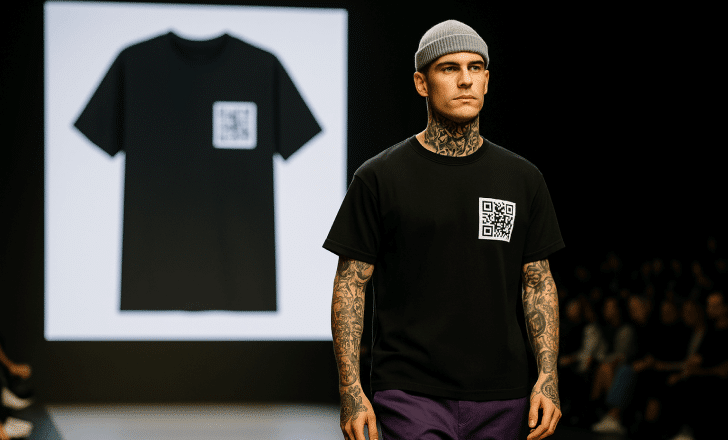
Can QR codes boost online store traffic for fashion brands?
Yes. For fashion brands, QR codes are a simple but powerful way to turn physical spaces into digital entry points. Add a branded QR code to a clothing tag, product packaging, shipping box—or even a storefront window—and you’re giving customers instant access to your online store.
One scan might take them to a product page, unlock an exclusive discount, or lead straight into an influencer campaign. It’s a smooth, mobile-first path from curiosity to checkout.
These quick response codes also drive social media engagement, connecting shoppers to styling tips, lookbooks, or brand content that lives on your social media platforms. For marketers, they offer a clear, trackable way to boost conversions, strengthen customer engagement, and keep the brand experience flowing—no matter where the journey starts.
How are fashion brands using QR codes to drive loyalty?
Loyalty isn’t just about points—it’s about connection. And fashion brands are using QR codes to build that connection in real time. Scan a code on a shopping bag, clothing tag, or product label, and you might unlock a loyalty program, receive an exclusive discount, or get personalized styling tips tailored to your taste.
These branded QR codes often lead to social media channels, influencer-led campaigns, or giveaways—keeping the experience going well beyond the checkout.
In the fashion industry, integrated QR codes make it easy to turn everyday purchases into ongoing relationships. It’s a smart, seamless way to reward loyal customers and keep them engaged with the brand they love.

Are QR codes in fashion all the rage on social media?
Definitely—and it’s not just a passing trend. QR codes have carved out a permanent spot in fashion marketing on platforms like Instagram, TikTok, and Pinterest. You’ll see branded QR codes everywhere: printed on product packaging, tucked into lookbooks, or featured on storefront signage—each one designed to drive social media engagement and reach digital-first shoppers where they spend their time.
Scan one, and it might take you to exclusive behind-the-scenes content, an influencer campaign, or a styling tip tied to the latest trend. These quick response codes don’t just boost visibility—they help brands turn online buzz into action, guiding followers to social media pages, limited drops, or product pages with just a tap.
For the fashion industry, they’re more than just scannable links—they’re tools for creating moments, building community, and making engagement feel effortless.
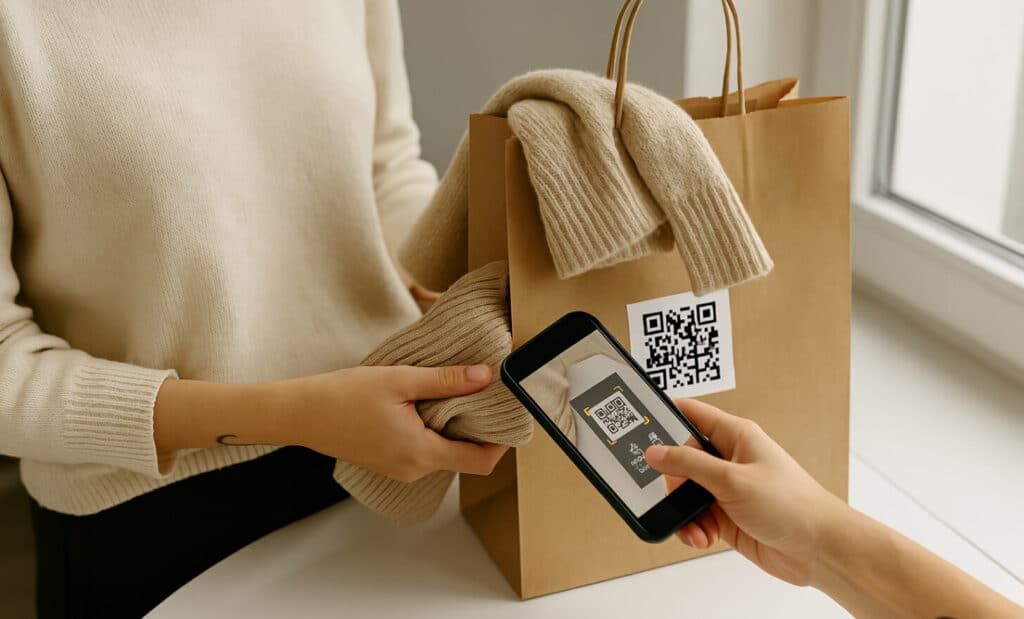
What’s the future of QR codes in the fashion industry?
The future of QR codes in the fashion industry lies in deeper personalization, smarter data, and more sustainable fashion practices. As technology evolves, fashion brands are using QR codes to unlock augmented reality experiences—like virtual try-ons and interactive lookbooks—accessible with a simple scan.
We’ll also see more dynamic QR codes on clothing labels and care tags, delivering real-time updates on stock levels, color schemes, ethical practices, and environmental impact. This shift empowers customers to make informed decisions while helping brands build trust and transparency.
As omnichannel strategies grow, QR codes will remain a key tool for bridging the gap between physical stores, online platforms, and social media engagement—offering the fashion world a scalable, digital-first way to enhance customer experience and brand loyalty.
Why are QR codes in the fashion industry more relevant than ever? Final thoughts
Fashion isn’t just about fabric anymore—it’s about connection. And today’s shoppers expect more than just a price tag. They want stories, transparency, and experiences that feel personal, whether they’re in a store or scrolling from home.
That’s where QR codes come in. A quick scan on a clothing tag or product label can unlock a styling tip, a lookbook, a loyalty reward—or even the backstory of how that item was made. These aren’t just conveniences; they’re bridges between the physical and digital, between brand and customer.
QR codes help fashion brands stay agile and human in a fast-changing world. From augmented reality to sustainable fashion, they make it easier to meet shoppers where they are—and to keep them coming back.
Because in the end, it’s not just about technology. It’s about making fashion feel more connected, one scan at a time.

